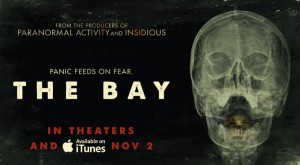BARRY LEVINSON on THE BAY By Richard Crouse
 Director Barry Levinson describes The Bay, his new found-footage film, as “a busy in-your-face movie.” The story of a Fourth of July eco disaster in the Eastern Seaboard town of Claridge has the shocks you expect from a horror film, but the scariest thing about the story is its plausibility. Levinson spoke about the film at the Toronto International Film Festival.
Director Barry Levinson describes The Bay, his new found-footage film, as “a busy in-your-face movie.” The story of a Fourth of July eco disaster in the Eastern Seaboard town of Claridge has the shocks you expect from a horror film, but the scariest thing about the story is its plausibility. Levinson spoke about the film at the Toronto International Film Festival.
The beginning: “It came up when I had a meeting about doing a documentary about the Chesapeake Bay. That was the first time I had heard that it was forty percent dead, that it is seriously polluted; has dead zones in it. It is a toxic soup. They asked if I would do the documentary so I started to do some research, and part of my research was learning that PBS had already done a done a documentary and given all this information. I was like, ‘Holy god, this is amazing. What a terrific documentary.’ But somehow people didn’t seem to be all that concerned.
The next step: “I think there is so much clutter that we just sometimes don’t pay attention. Then I thought, maybe we need to take all that science, all of those facts and put it into a storytelling mechanism. A film, with characters struggling on that given day and maybe that makes the facts more interesting because we’ve given a real context to it all. People will die. This will happen. That’s what led to the idea of doing The Bay.”
The “found-footage” set-up: “If it was going to be a documentary why don’t we shoot it as though we collected all the footage from all these different people? That just by its nature seemed to be the way to go about it. That made the most sense. Then you have to use unknown actors because if you use really well known actors it kills all the credibility. Even though we’ll know it’s a movie if you try and say this is actual footage shot by these people and it’s Brad Pitt, it kills all credibility.”
“Found footage is normally pretty contained. It’s in a house. You’re in the woods. Here you’re all over the place. You’re underwater, you’re above water. It has a bigger canvas to it. But it was the footage that was collected to make sense of what happened and who didn’t do what they should have done, etc.”
